When I was a young man in the 70s, my brother and I spent a lot of time on police ranges, because our dad was an officer and rangemaster for the California Highway Patrol (CHP). As “range rats” of the highest order, we gladly took care of the chores that none of the officers wanted to do, such as posting targets, policing spent brass, issuing ammunition, and so forth.
In between relays, we got to shoot a bit ourselves. Mostly it was with our .22s, but sometimes we shot our dad’s duty gun (a 6” Python) with the hot .38 Special cartridge issued by the Patrol. This cartridge, known as the “Treasury Load,” is frequently confused with the more popular “FBI Load,” and there’s a lot of misconceptions about it in the shooting world. Therefore, I thought the RevolverGuy audience might enjoy it if we explored this interesting bit of revolver history and set the record straight on it.
Back In The Day . . .
If you could go back in your time machine to the 1950s or 1960s to visit with an American police officer, you could pretty much bet your return ticket that he’d be carrying a .38 Special revolver loaded with cartridges that contained 158 grain, round nose lead (RNL) bullets. This ammunition was used almost exclusively, despite its well-deserved reputation as a poor fight stopper, because there really weren’t many other options in the most popular of police calibers. At best, you could switch to a semiwadcutter (SWC) design, which might do a better job in some situations (such as, if a bone was hit), but you could still count on it overpenetrating the target and generally performing quite miserably. Any serious attempt at improving your sidearm’s potency would have to begin with a caliber switch, moving up to a .38/44, the .357 Magnum, or one of the big bores beginning with a “4.”
A small group of experimenters was determined to change this state of affairs, and get the .38 Special up off its knees. In the late 1950s, men like Jim Harvey and Lee Jurras were playing with jacketed, .35 caliber rifle bullets that had been turned down on lathes, and given a hollowpoint cavity up front. They shot them in .38 caliber revolvers with great results, and were encouraged to develop the concept.
A Super Idea
Harvey and others like him were making important contributions to the birth of jacketed hollowpoint (JHP) bullets for handguns, but it was Jurras who turned the idea into a commercial reality. In 1963, Jurras established an ammunition company to go mainstream with the idea of pushing a jacketed hollowpoint bullet at fast velocities to promote expansion out of handguns. His company, known as SuperVel, would seriously upset the apple cart with this radical idea.
Jurras’ early JHP designs were unlike anything the market had seen. There were molds available to cast all-lead hollowpoints before this, but the relatively soft bullets smeared in barrels when pushed too fast. Encasing the base and the bearing surface with a copper jacket prevented leading, while allowing the unjacketed front end of the bullet to remain soft, for expansion. There had been no commercially-available handgun ammunition loaded with JHPs like this prior to Jurras bringing them to market.
The JHP design was only part of the special formula, though. The other part was the use of a lightweight-for-caliber projectile that was launched at high speeds, to ensure the cavity would open. Those old, heavy, 158 RNL bullets plodded along somewhere in the 800 fps range (and possibly slower) from the 4” guns carried by most police officers, but Jurras’ new .38 Special load pushed a lightweight, 110 grain JHP out the barrel in the neighborhood of 1,100 fps. At this speed, the primitive hollowpoint had enough energy to expand, increasing the effect of the bullet while also reducing the likelihood of overpenetration.
With his high speed, lightweight, JHP designs, Jurras was not only introducing a new technology to the market, but an entirely new philosophy for achieving the desired performance from a defensive handgun. When introduced around 1965 to 1966, the idea captured the imagination of the shooting world, and when the highly influential Los Angeles County Sheriff’s Office contracted with the fledgling company in 1967, it accelerated law enforcement interest in the concept of a high speed, lightweight, JHP.
Sadly, the innovative SuperVel company soon fell on hard times, and closed its doors by January of 1975, but the high speed, lightweight, JHP was an idea that was too compelling to go away.
Not Just Currency
In the 1970s, the Department of the Treasury was the home to such diverse law enforcement agencies as the Customs Service and the Secret Service. Given the unique nature of their mission, the latter was intrigued by the idea of a hard-hitting, .38 Special load that wouldn’t overpenetrate and risk injury to innocent bystanders.
At the time, the FBI was starting to look hard at the 158 grain lead semiwadcutter hollowpoint (LSWCHP) which had been pioneered by the Saint Louis Police Department (accordingly, the Winchester product code for this load was “W38SPD”). This cartridge was loaded to Sporting Arms and Ammunition Manufacturer’s Institute (SAAMI) +P pressures, and clocked around 900 fps in the early versions out of a 4” barrel (1000+ fps velocities were reported by some sources, but these were probably from test barrels, not real guns), but before long the recipe was changed and velocities dropped about 100 fps. The FBI adopted this cartridge in 1972, leading to the popular “FBI Load” moniker, and kept it until it was replaced by a 147 grain +P+ Federal Hydra-Shok in the late 80s.”
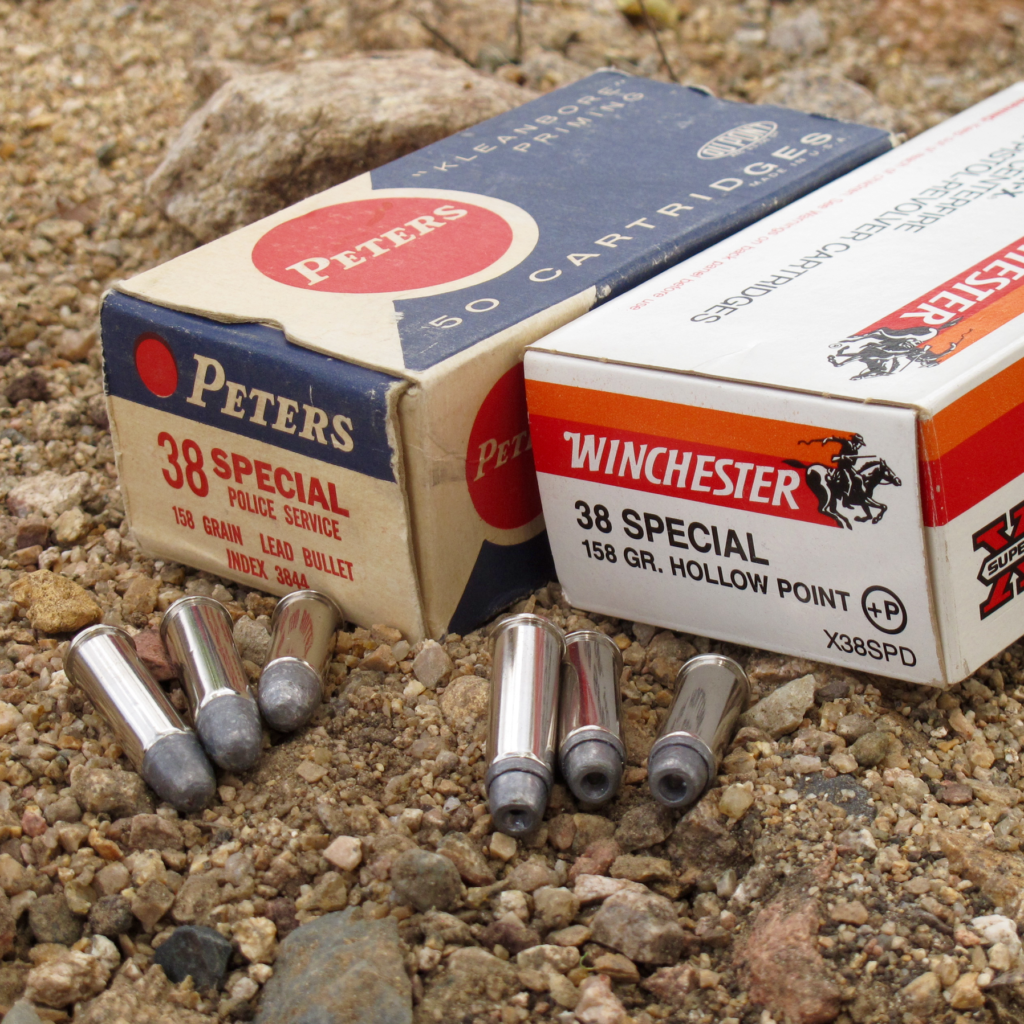
The 158 +P LSWCHP developed an early reputation for excellent performance in such diverse cities as Saint Louis, Chicago, Dallas and Miami, but the Secret Service was more drawn to the high speed, lightweight JHPs pioneered by SuperVel. The 110 grain JHP at around 1,100 fps was especially attractive to the Secret Service, because the bullet still had sufficient velocity to expand when it was fired out of a compact revolver, like those frequently carried by the plainclothes agents. The 158 +P LSWCHP performed great out of a 4” or longer service gun, but when it was fired in a 2” gun it frequently failed to expand and risked overpenetration, which was unacceptable in the crowded environment that characterized the Secret Service operation.
The Real “Q”
So, with SuperVel already struggling to meet demand and pay the bills (largely because the majors were choking off their supply of new cases) the Secret Service contracted with Winchester to supply the desired product.
Then and now, it was standard practice at Winchester to add a “Q” prefix to the product code of loads developed for law enforcement and military contracts. As a result, the load developed for the Treasury Department’s Secret Service was given the product code, “Q4070.”
Not surprisingly, the Q4070 load followed a familiar pattern. It had a 110 grain jacketed hollowpoint that clocked about 1,100 – 1,150 fps out of a 4” barrel, and about 1,000 – 1,050 fps out of a 2” tube. The 1,000 fps mark was a critical target, because designers hadn’t yet learned how to optimize the shape of hollowpoint cavities, and these early bullets needed the velocity to develop enough hydrostatic shock to force the walls of the cavity open.
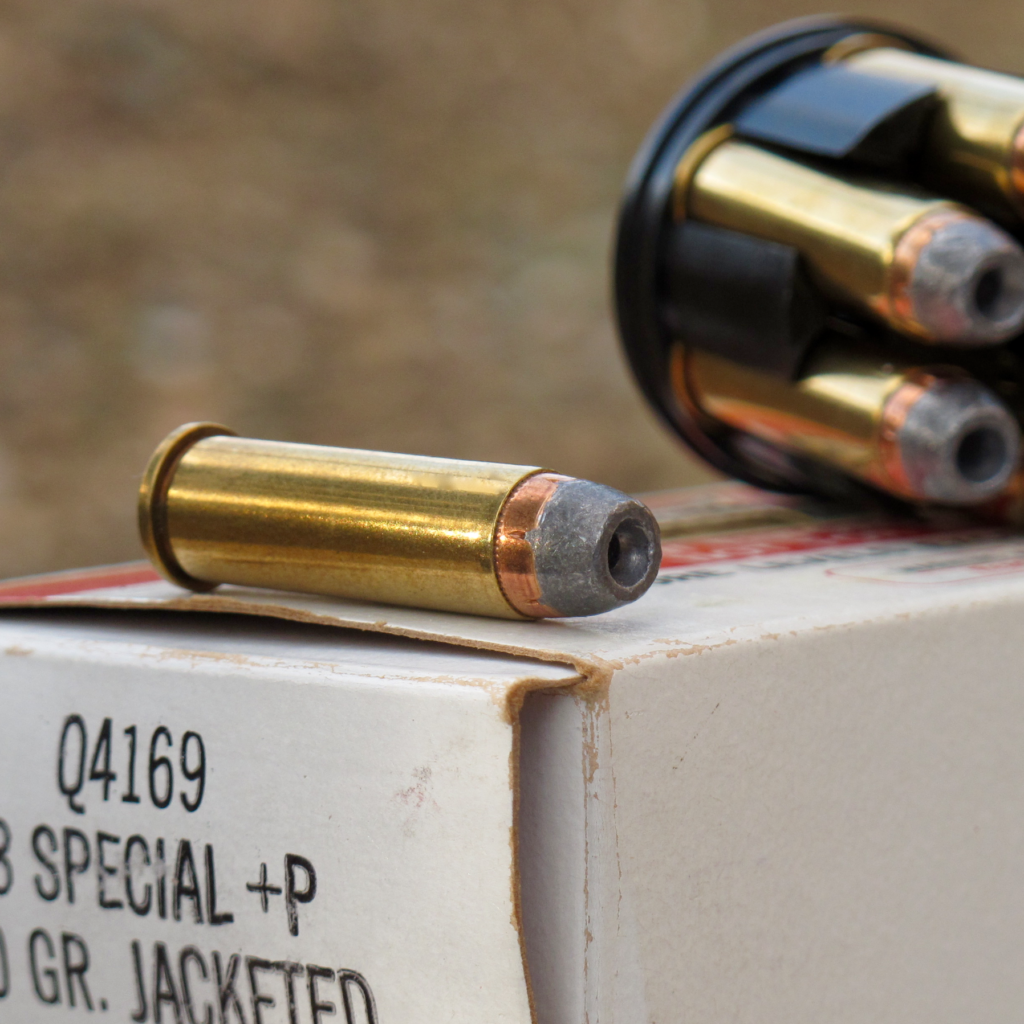
Reaching this velocity with available powders was not possible within the industry standard pressure limits for the .38 Special or .38 Special +P. At the time, SAAMI used a non-linear unit of measurement known as a “copper unit of pressure” (c.u.p.) to evaluate internal case pressures (now superseded by the more precise pounds per square inch, or p.s.i.). Standard pressure .38 Special was capped at around 18,900 c.u.p. (now, 17,000 p.s.i.) and the higher pressure .38 Special +P was capped at about 22,200 c.u.p. (now 20,000 p.s.i.), but even this wasn’t high enough to reliably squeeze 1,100 fps out of the cartridge. As a result, Winchester took the unprecedented step of loading the Q4070 to pressure levels that exceeded SAAMI standards by 15% – 20%. This made the Q4070 a 23,500 c.u.p. cartridge, which was well beyond any of the .38 Special or .38 Special +P loads from the major manufacturers.
Under Pressure
Since Winchester had exceeded SAAMI standards for the .38 Special +P, and didn’t want the ammunition to find its way into older revolvers with questionable metallurgy, or newer revolvers with aluminum frames or cylinders, they marked the cartridges with a first-ever “+P+” headstamp (“WCC+P+” on top, and “xx” on the bottom, where “xx” represented the year), and marked the packaging with a warning that covered the entire rear panel of the box. Winchester would only sell the ammunition directly to law enforcement agencies (a “For Law Enforcement Use Only / Not For Retail Sale” warning on the box would later cause consternation among the misinformed when surplus made its way into the commercial market), and even they had to sign a waiver that acknowledged the potential for firearm damage as a result of the nonstandard pressures.
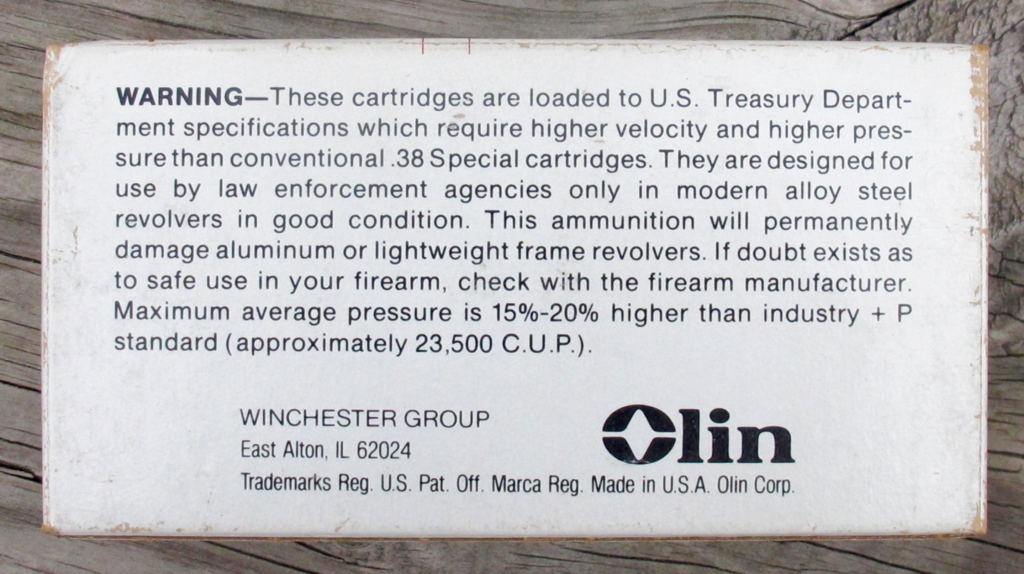
In truth, the SuperVel load that preceded the Q-load was probably operating in the same region (numerous anecdotal reports indicate the SuperVel load was actually hotter, and gun writer Patrick Sweeney recently discovered that an old box of SuperVel 110 grain .38 Special tested over 1,700 p.s.i. beyond the SAAMI .38 Special +P pressure limit but the small outfit had never marked their cartridges accordingly. As a SAAMI-compliant operation though, Winchester wanted to ensure that everybody understood this was a tiger of a different stripe.
Science . . . Fiction?
Shortly after the Secret Service’s adoption of the Q4070, which became universally known as the “Treasury Load,” the federal government launched an intensive study of police ammunition that was funded by the National Institute of Justice (NIJ) and their Law Enforcement Assistance Administration (LEAA). The project, which began in 1973, introduced the concept of the Relative Incapacitation Index (RII), which was intended to allow comparisons between ammunition and express a load’s ability to stop an opponent.
The RII was the output of a model that had many flaws. The worst were an overemphasis on temporary stretch cavity dimensions and a scoring system that rewarded shallow penetration depths. In the model, only frontal torso shots were evaluated, and since the vital organs are close to the surface of the body from this angle, the model favored loads that expanded quickly and created a large stretch cavity in 20% ballistic gelatin very early in the wound track.
Rounds that performed like this were given a higher RII value than those that didn’t when the test results were published in 1975. For example, the low energy, non-expanding, and highly penetrative 158 RNL received an RII of only 8.6, but the high energy, rapidly expanding, and shallowly penetrating Treasury Load scored a 17.9 RII. The FBI Load didn’t score as well as the Treasury Load, earning a 17.2 RII in the test.
Street Results
Buoyed by the results of the NIJ study and its prestigious adoption by the Secret Service, the Treasury Load was adopted by many federal, state, county and municipal agencies across the country. The largest of the non-federal agencies was the influential California Highway Patrol, which adopted the round in 1976 along with their new Smith & Wesson Model 67 and 68 revolvers, and their Second Six speedloaders.
For agencies that were accustomed to the performance (or lack thereof) of 158 RNL, the Treasury Load was a significant improvement. Officers and agencies reported that the round hit harder, and did a better job of stopping hostilities than the old 158 RNL “widow maker.”
However, there were still some issues with the new round. The biggest problem with the Treasury Load was its shallow penetration (using a modern day yardstick: About 10” through heavy denim into 10% ballistic gelatin from a 4” gun, as compared to 13” – 15” for the FBI Load), which prevented the bullet from going deep enough on some cross-torso shoots, some shoots where an arm was struck before the round entered the torso, or even some frontal shoots on very large individuals with a lot of fat or muscle mass. Additionally, the round often didn’t have what it took to get through tough intermediate barriers like automobile bodies.
But these criticisms have to be measured by the standards of the period. Today, we’re spoiled by advanced, “barrier blind” bullets that can punch through intermediate obstacles and still have enough energy to penetrate and expand in the target, but not overpenetrate. We can “have it all” with today’s high-tech bullets, but at the dawn of the 1970s things weren’t as good. Back then, you could choose from: A low energy icepick (.38 Special 158 RNL); A high energy icepick (anything in .357 Magnum); A low energy, pure lead hollowpoint that would penetrate reasonably, but might or might not expand (the FBI Load), or; A high energy, jacketed hollowpoint that would almost always expand, but not penetrate very deeply (the Treasury Load). If you wanted to get into cars, then you had to dump the .38 Special entirely and go with a .357 Magnum firing 158 grain semiwadcutters or jacketed softpoints, and expect them to overpenetrate in human bodies like a hardened drill bit. You pays your money and you makes your choice.
Industry standard test protocols, 10% ballistic gelatin, 12” minimum penetration depths, and an emphasis on permanent crush cavity over temporary stretch cavity were all still more than a decade away when the Treasury Load knocked its first felon into the dirt. Judging by contemporary standards, the Treasury Load was a really attractive option.
As a result, many agencies made it their own. It generally performed well for them in the street, particularly out of energy-robbing snubs (which were tough on all loads, but especially the FBI Load). While the FBI Load was more popular and widespread, its track record in police shootings was virtually identical to that of its high speed, lightweight cousin. You could argue a good case for either load, but one thing that everybody agreed on, is that the two competitors offered a dramatic improvement over the dismal 158 RNL that they replaced.
Other Issues
One difference from the FBI Load was the strain that the overpressure Treasury Load put on the guns and shooters that fired it. The Treasury Load had a loud bark and made a lot of flash for a .38 Special (more so than the 158 +P LSWCHP) and this could be a difficult issue for some shooters to overcome.
More significantly, the intense pressure generated by the Q-load took a toll on frames, cylinders, and lockworks. Even the stronger .357 Magnum revolvers suffered from accelerated wear when fed a steady diet of the Treasury Load. Magnum loads would wear a gun out faster, but the Treasury Load came close, and created stretching and endshake problems much faster than any other .38 Special or .38 Special +P did (but that’s a story for another time).
Lastly, the Treasury Load could be really dirty (especially in short barreled guns). The burn left a lot of soot, and a lot of extra powder flakes left behind to migrate under the extractor star and into all the nooks and crannies that you’d normally want to keep clean on a wheelgun.
The Other Treasury Load
Federal Cartridge Company introduced their own version of the Treasury Load shortly after the Q4070 appeared from Winchester, and assigned the product code “38F – TD” (“TD” for Treasury Department) to it. Like Winchester, Federal restricted sales of this product to law enforcement agencies that were willing to accept the risk of operating beyond SAAMI +P pressure standards.
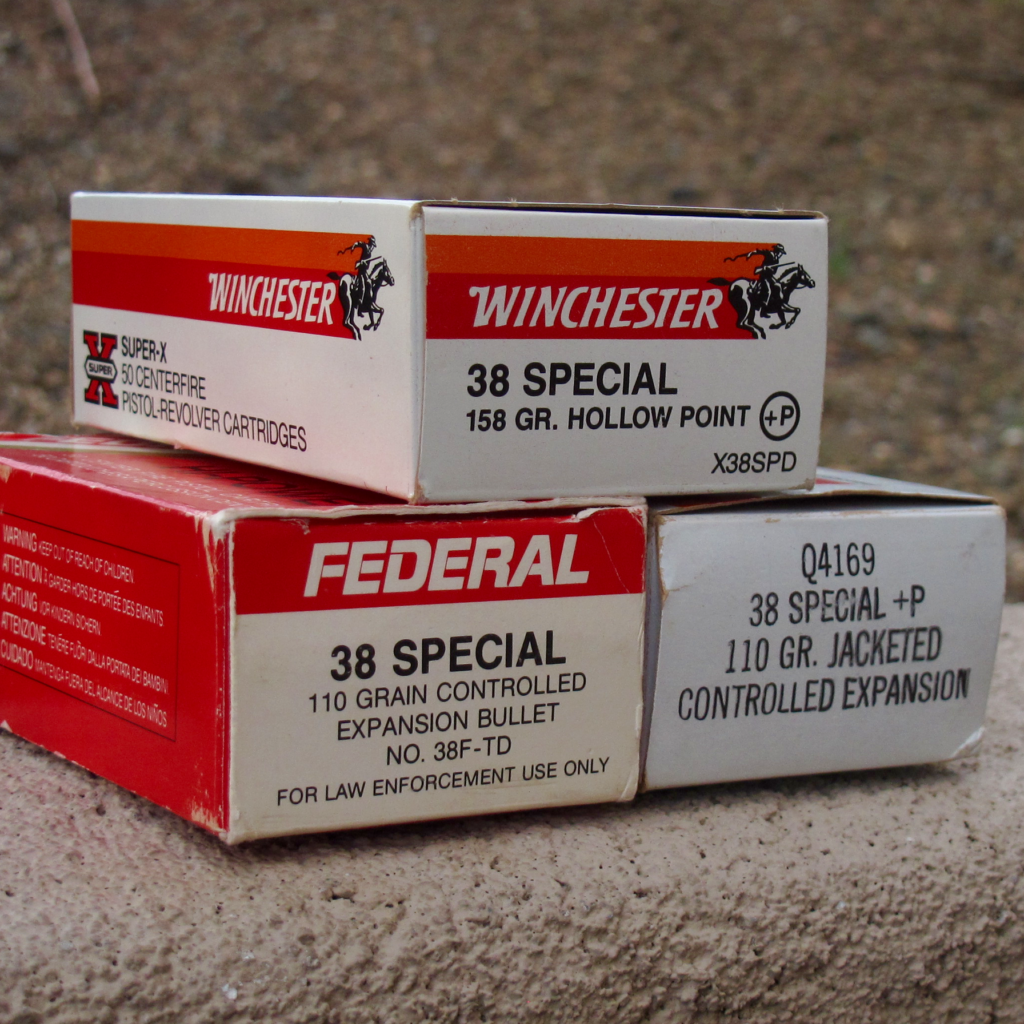
Federal didn’t headstamp the cartridges or label the packaging with the “+P+” logo like Winchester did, but these were definitely +P+ loads. The Federal cartridges started with a “FC LE” headstamp, and later went to a “FC xx” headstamp, where “xx” represented the year of manufacture.
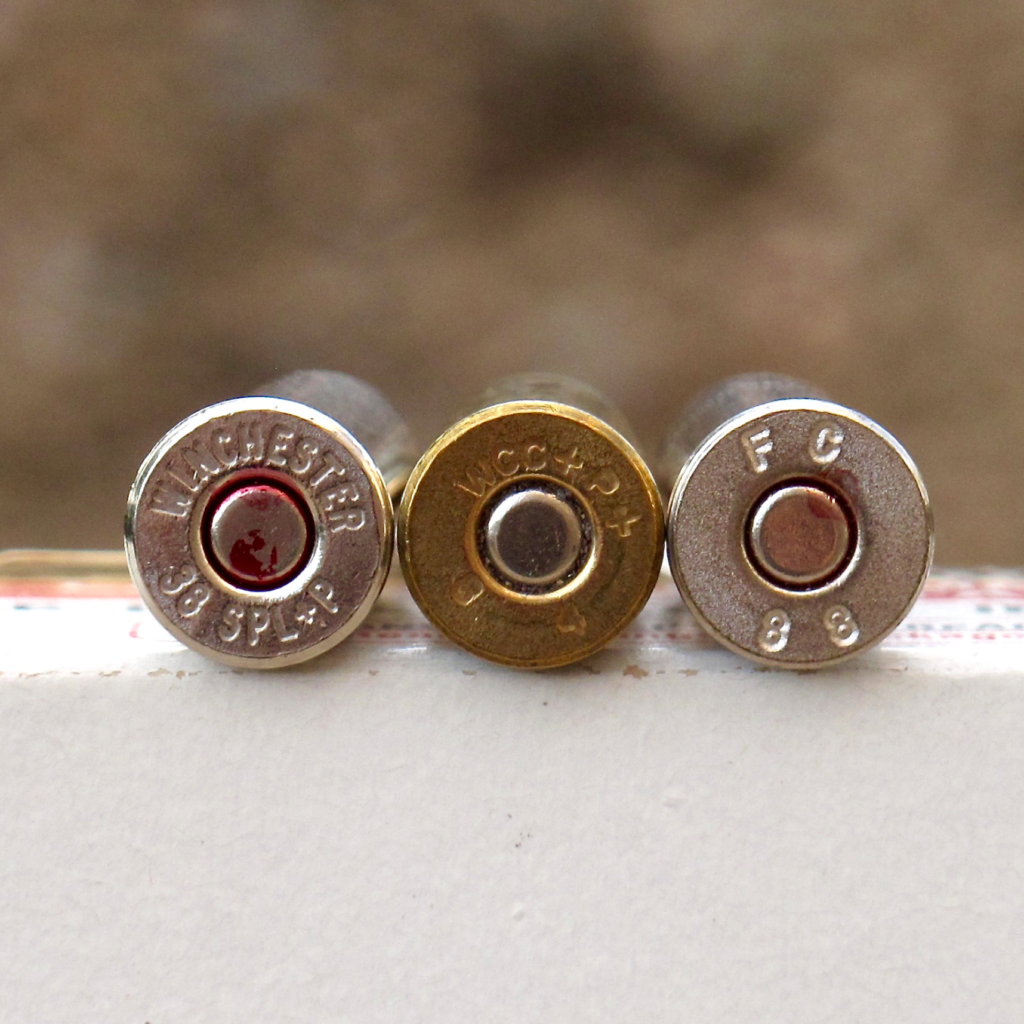
The two products were similar in design and construction, but there were differences between them. While both Winchester and Federal made continuous changes to the cartridges over their lifespan (i.e., new cavity designs, the addition of jacket skives, changes to jacket lengths, different powders, etc.) it can be generally stated that the Federal version of the Treasury Load wasn’t loaded as hot as the Winchester, had a bigger hollowpoint cavity, was less consistent in terms of velocity, and the Federal bullet wasn’t as robust.
In service, many agencies reported that the Federal bullet expanded to greater diameters than the Winchester and was prone to fragmentation, especially when fired from 4” or 6” barrels (like the Winchester, it expanded but didn’t fragment in the 2” snubs). Therefore, the Federal didn’t penetrate as deeply as the Winchester product, which typically clocked 50+ fps faster than the Federal and retained its full weight with greater reliability.
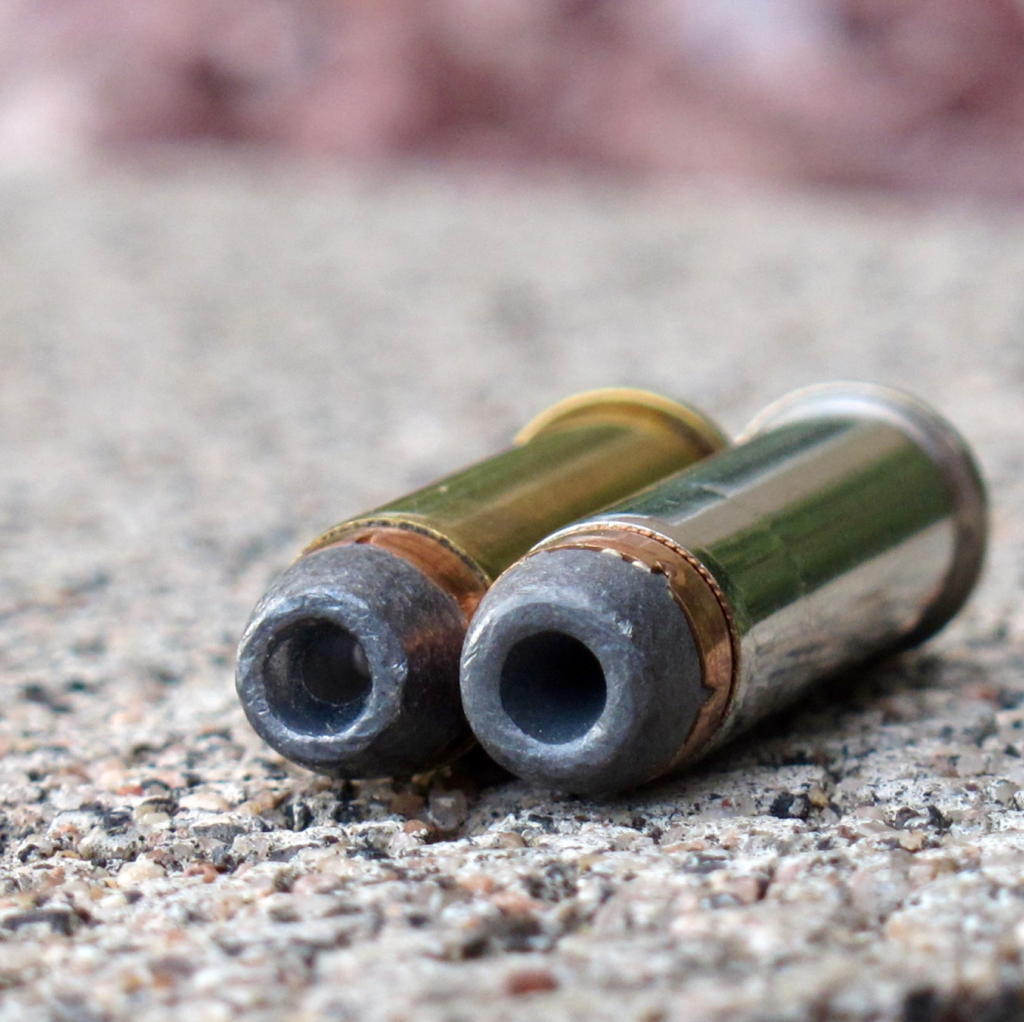
The Federal 38F – TD was treated as a “substitute standard” by many agencies for the Winchester Q4070 load, but some agencies used it exclusively. The Federal load was used by such agencies as the U.S. Border Patrol (1980 – 1984) and the Los Angeles County Sheriff’s Department (late 1970s to 1992) as their mainstay, while others (such as the CHP) used it intermittently with the Winchester product, as contracts changed.
Interestingly, the agencies who complained the most about failures with the Treasury Load were those who used the Federal product. The inconsistent velocities, explosive fragmentation, and shallower penetration of the Federal round seem to have handicapped it as a general issue, police duty round. The agencies using the Q4070 load seemed to be more satisfied with the results on the street.
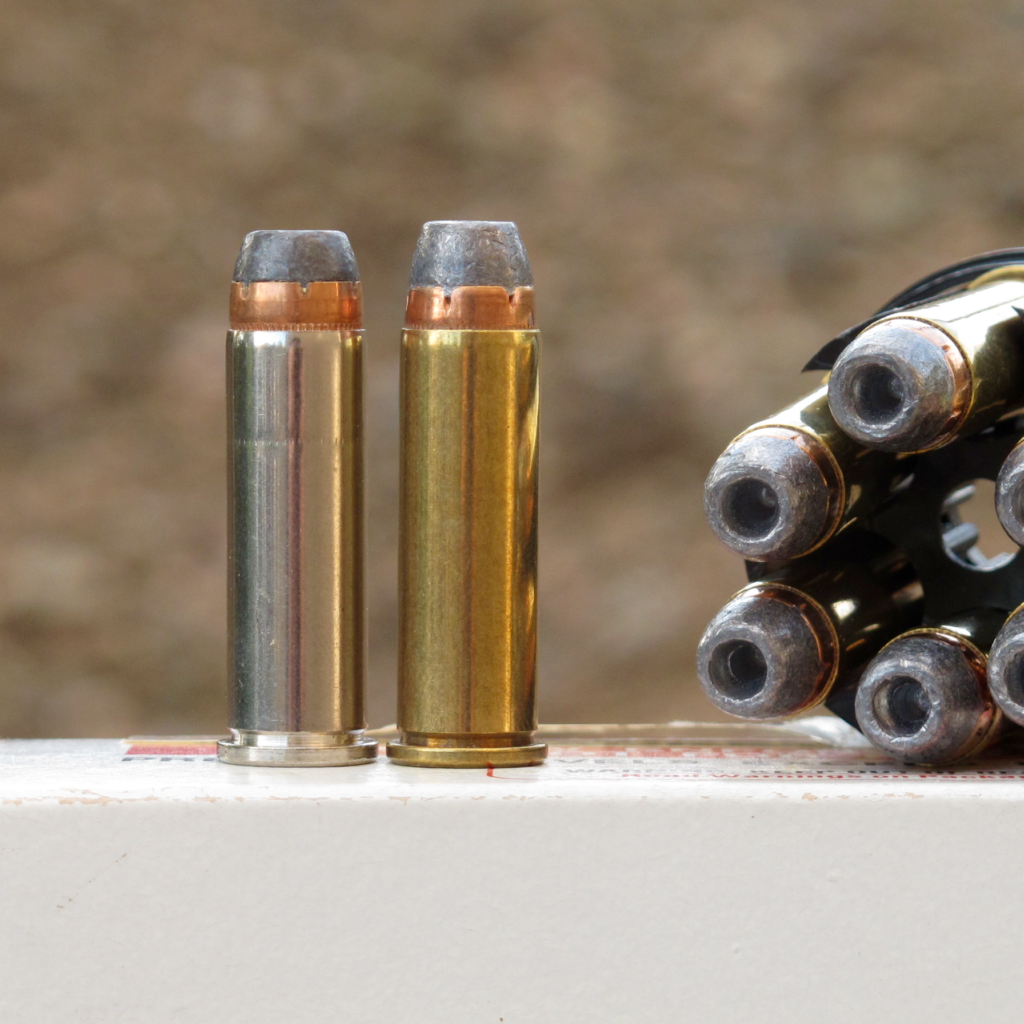
Changes
As mentioned, Winchester and Federal tweaked and advanced the designs as they matured over time. The Winchester Q4070 product code evolved into a Q4169 product code in the mid-1980s, and again into a RA38110HP+ product code in the late 1990s.
Yet, neither of the companies relented on their “law enforcement use only” policy, so other manufacturers, such as Cor-Bon, stepped up to provide their own +P+ versions of the Treasury Load to a hungry commercial market in the late 1980s to early 1990s. Many of these were actually loaded beyond Winchester’s own +P+ pressure specs, plunging shooters ever deeper into uncharted territory.
In time, advances in bullet designs and propellants allowed manufacturers to deliver the desired performance within SAAMI .38 Special +P pressure limits, and the .38 Special +P+ loads disappeared from the market. Even the reincarnated SuperVel has managed to stay within SAAMI +P specs on their new .38 Special load.
The Treasury Load was a big advance in its time, but we have better alternatives to choose from today. Still, I think Lee Jurras would be amazed by the avalanche that his little SuperVel rock started!

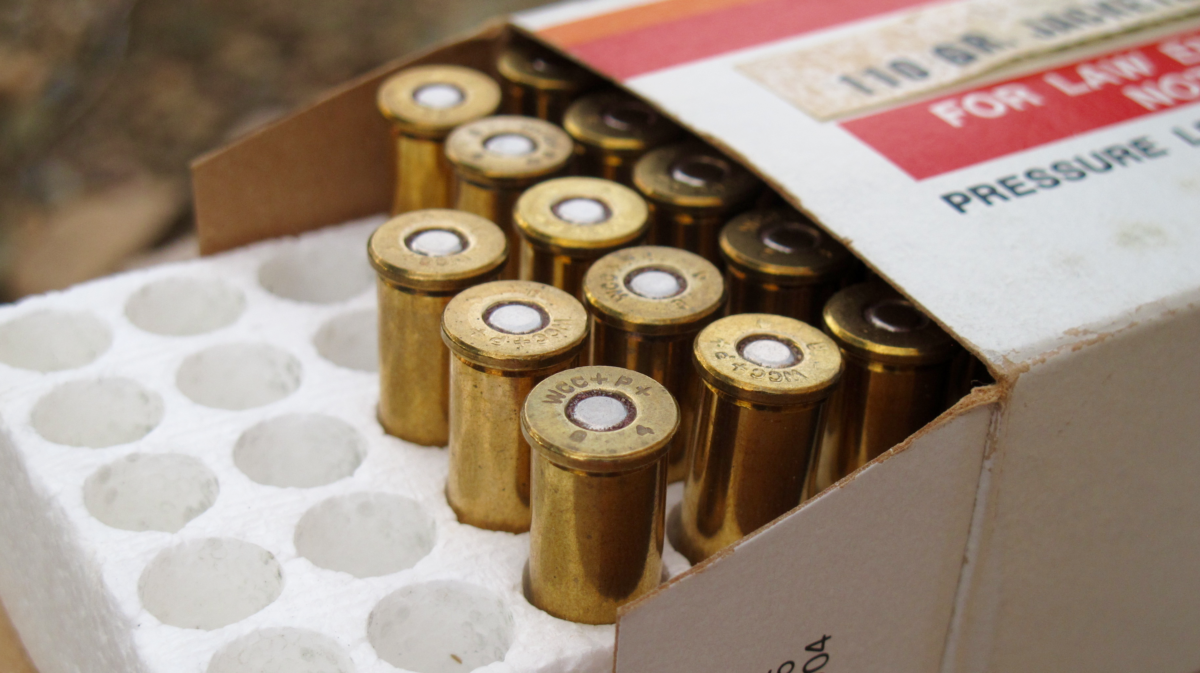
Well done, thank you for the history lesson.
The author has left out one of the main factors behind the .38 Special +P+ standard: politics. During the late 1960s and 1970s, LE agencies were phobic about issuing .357 Magnum revolvers and ammunition due to pressure from leftist groups. It was hard enough to get hollowpoints issued without the added outcry over Magnum ammunition.
Not left out, just located in a companion article that’s about ready to go to the Editor. I was already being issued citations for exceeding the word limit. ; ^ )
Thanks for reading!
Looking forward to it.
By the way, I have a link to a reprint of the infamous July 20, 1970 article from “The Nation” that decried the increasing use of hollowpoints by LE agencies: “The Dumdum Bullet: Vietnamization on Main Street.” It basically formed the talking points for many of the later protests levied by the ACLU and other groups.
Ditto. Early in my career carrying beloved S&W HB K’s (13 & 66), we experienced this as well. “No magnum loads, no city in the North East allows them”…Blah, Blah, Blah. Still, the 125gr +P seemed to hold its own. I miss my 13!
That was a cool blast from the past, Mike. For the few minutes it took to read it was nice to feel like a young man in the ’70’s again. Thank you!
For sure, Super Vel was the cat’s meow back in the day. Young handgunners today often don’t appreciate how far we’ve come and how good we have it. All the hardened lead alloys and gas checks and all the other tomfoolery… trying to get a small-caliber pistol bullet to go fast enough to do something. Nowadays, of course, we’re blessed with any number of outstanding, effective loads. And the basics of terminal ballistics are sufficiently known and accepted that you just sorta shake your head when you see an old picture of a police officer back in the day, with the loops in his gun belt filled with 158gr lead round nose. And not a speedloader in sight.
Thanks for the ride in the time machine. And tell that editor of yours to give you as many words as you like!
Mike,
Again, an excellent article that brings back the good old days before we arrived at today’s excellent days. As a new range officer in 1990, I remember being alone at the range for the first time. I started opening doors and drawers to inspect my surroundings. There was a battered old grey steel file cabinet full of ancient records. The bottom drawer was catawompus to its housing and almost impossible to open. Challenge accepted, I yanked with all my might to pull it open. It was full of ammo. Old boxes of .38s and loose rounds as well. Digging through the 158 grain round noses and semi-wadcutters and all lead hollowpoints revealed a few rather plain looking yellow boxes. I recognized them immediately as Super-Vels. Full with 50 rounds each. Neato! There were also some .41 Magnums but I forget who manufactured them. There was still one officer on my department carrying a .41 still in 1990. Some Pythons as well. Thanks for a great article, bringing back good old memories!
Jeff, Steve, thank you for the kind comments! You made my day! Glad you enjoyed my wanderings.
Jeff, when my dad hit the streets in the 60s, he had a revolver, 18 rounds of RNL, one pair of handcuffs, and a stick. Somehow, he and all the other officers managed to get the job done in one of our country’s most turbulent and violent eras. Things have certainly changed since then, and we’re not just talking about equipment!
Steve, that wasn’t a filing cabinet you forced open, but a combination treasure chest and time capsule! Wow!
Mike
Great article, thanks! Its interesting to see how the “FBI Load” compares to the more modern stuff in Lucky Gunner’s testing.
Outstanding article, Mike, very well written and thoroughly researched. You may be the only commentator out there who got it right on the pioneering work of Jim Harvey and Lee Jurras (unbeknownst to each other, they were approaching the same problem from the same angle). Lee Jurras and Ernie Wallein were partners in the original Super Vel (1963-1975) after which the IRS seized the Super Vel assets and auctioned everything off to pay the 11% excise tax on ammunition which, for reasons unknown, Lee and Ernie had not been paying. The buyer of the Super Vel factory and all its assets was William Hamilton from nearby Greensburg, Ind. Original Super Vel was marked “Super Vel Cartridge Company, Shelbyville, Ind.” which featured “Jurras bullets” but after Mr. Hamilton took over, the packaging remained identical except the name was changed to “H&H Cartridge Company” (William Hamilton had a brother, hence the H&H) and also the reference to the bullets was changed from “Jurras bullets” to “special bullets” because the new owner did not have the right to use Jurras’ name. (Prior to Super Vel, Lee ran a company called Jurras Munitions.) Mr. Hamilton was not a “gun guy” so his H&H Cartridge Co. did not last long. The name was then sold to FPC Inc. from Wisconsin who made training ammo under the brand name Super Vel Qualifier. This was (pardon the pun) and unqualified failure as police agencies wanted hollowpoints, not roundnose training loads. Super Vel Qualifier was out of business by the early ’80s. Out of circulation and out of production, Super Vel’s trademark languished and was finally deemed “abandoned” by the US Patent & Trademark Office until I came along in 2013 and, with Lee’s permission, bought the trademark. It’s important to note that I did not legally need Lee’s permission, however, it’s not right to take a man’s property without his permission, even if he technically doesn’t own it, so I called Lee and got his blessing before resurrecting Super Vel. Lee Jurras passed away about two months ago. The new Super Vel Cartridge Company is struggling to get going but we’re making strides and will be in gunshops nationwide soon. Until then, it’s available online at http://www.supervelammunition.com or, starting in October, from Dillon Precision’s Blue Press catalog. Thank you, Mike, for a great story.
Cameron, thank you for the kind words and for the neat additions regarding SuperVel history. It’s exciting to see you post here, after reading your byline for so many years in AH and elsewhere.
I’m glad to see the yellow and red box back on the shelves again, and look forward to seeing what you cook up next.
By the way, the new pin-up logo rocks!
Federal also made a 125 gr. JHP .38 special +P+. The boxes I have are marked “.38 SPECIAL” “125 GR. JHP BULLET” “No. 38E – IL” and “For Law Enforcement Use Only” with undated “FC LE” headstamped nickel cases.
I’m familiar with it through its use by the revolver armed agents of the former Illinois Bureau of Investigation after they were rolled into the state police detective section. Reportedly, all agents were then allowed to chose either a 2 1/2 inch S&W Mdl. 66 or a S&W 9 mm pistol.
Fascinating! Thank you for sharing this, Sir!
I was unaware of this load. Can you approximate the timeframe when these were manufactured / issued? Any idea of what kind of velocities were achieved in the M66’s with this load?
Doh! Typo – Choose
I’d estimae the time frame for the Federal .38 was 1980 plus/minus a couple of years. Plus -Federal had the Illinois 9 mm contract about then, before the adoption of the WW +P+ 9 mm.
I have no idea what the ballistics might be.
Second guessing myself, I feared I might be wrong in my memory that it is indeed +P+, having only the oral statement of the state police range master who gave them to me. Your sample box not being so marked either encourages me that my memory is correct.
What year did SAAMI first adopt the +P designation, and am I correct in remembering that +P+ designations are not a SAAMI standard?
Yes Sir, you’re correct in saying that +P+ is not a SAAMI standard.
SAAMI only recognizes +P for .38 Special, .38 Super, 9mm and .45 ACP to the best of my knowledge. I’ve seen some .380 ACP marked +P, but I don’t think SAAMI has a .380+P standard, and believe that’s non-standard ammo.
I don’t know the exact year that the .38+P standard was published, but would presume it was early 1970s, coincident with the 158 LSWCHP load developed for Saint Louis PD (and later coined the “FBI Load”).
Since Federal didn’t headstamp their ammo +P+ or use that designation on the end flap all the time, the round you described could possibly have been +P+. I’ll try to investigate with some of my sources.
Thanks again for writing!
CM, I was able to talk to an authority that worked for Federal during this timeframe, and he advises that the 125 grain load was actually a +P load, not +P+. The “For LE Use Only” label was designed to differentiate this contract product from others in the line, and to discourage its use in unsuitable guns (i.e., aluminum frame), according to my source. He tells me that Federal did one contract run of this load for ISP, and the contact probably only lasted a year or two.
Hope that clears it up! Thanks again for writing!
I confirmed my original source statement that the .38LE was +P+. Of course, he might be wrong, and an oral report isn’t worth the paper it’s written on. MY Federal contact is not responding.
I tried email to Federal with this response: “If the headstamp doesn’t say +P or +P+ then it is standard pressure. Thanks. Federal”
So, there – that Federal 110 gr +P+ in FC LE cases doesn’t really exist!!!!
I have two guesses why ISP might bother with a special contract loading instead of buying over the counter +P .38: Nickel instead of brass cases or low flash powder.
Great fun. Thank you for a great web site.
This is interesting! I hope you can find something that verifies it one way or another. It would be neat to “discover” another +P+ load that I didn’t know about.
You may be on the right track, regarding the contract. It could have been +P with some special, requested feature like a nickel case or low flash powder that they couldn’t get “over the counter.”
Thanks again for the interest, and please let us know if you find anything else out. I’ll do the same.
My first issue was Federal 110+p+ in the red/white box. Headstamp for 1979 was FC LE box states loaded to Treasury Dept specs requiring higher pressures..blah blah blah. Just like Winchester. People who answer phones and email at firearms/ammo companies in my experience are clueless and reading from a script. To this day Smith and Wesson will tell you not to fire 38 110+p+ in any 38 or 357magnum unless the gun is marked for +p+ on the frame. This despite their revolvers having shot maybe a million rounds of the stuff. Logic would tell you 38+p+ is lower pressure than 357 but phone people generally lack both product knowledge and in my experience common sense. Even had one tell me two of their same model revolvers are not guaranteed to use the same speedloader because of tolerances.
My understanding on the 125+p+ was a 4in velocity of 1000fps vs the typical 945-950. I know it was out into the later 80’s at least…..1987 or so.
My experience with the 110+p+ is just what you article states. The Federal version was issued by LASD starting I believe in 1979. The bullet went thru many variations in skiving, hollowpoint cavity size and the amount of lead exposed on the nose. In shootings I am aware of with it fragmentation occurred when fired from 4 or 6in revolvers. For the last couple of years we switched over to Winchesters version. In recent testing I got an avg for 5 shots of 1085 thru a 2.25 in Ruger and 1124 thru a 3in Ruger. I still have no problems putting the Winchester version in any of my revolvers and going about my business.
Should have said the chrono was the Winchester
Sir, thank you for the excellent information and for your LE service as well. I’m glad my reporting was consistent with your experience with this load.
The Federal 110+p+ did an avg of 1062 from a 3in sp101 in fairly recent testing.
Great article. Made me hunt through my ammunition and sure enough I have a box of the Winchester and a box of the Federal Treasury loads issued by the CHP to my good friend who graduated from the CHP academy in 1969.
He wasn’t far behind my dad, then (1968). Glad you enjoyed the article Ryan!
I started working at a rural sheriff’s office in Ohio during the middle 1970s. We had to provide all of our own equipment and ammo. I loaded my Ruger Service-Six with 3 rounds of the 125 grain HP +P and three rounds of 158 grain SP +P, alternating with the first round being the hollowpoint. I figured one or the other round would do what needed done.
Many years later when I was involved in an on-duty shooting, I had a Beretta 92S, and had 115 grain HP +P. They worked and got me home that terrible night. I always felt confident with the .38 caliber rounds I had used early in my career, it seemed to be the best available at the time, I couldn’t have done any better. Great article, thanks!!
Sir, thanks for your observations and your LE service. I’m glad that 115+P got you home safely. Thanks for writing!
Others were working on hollopoint high velocity loads in the 1930s. Read up on the Lyman 358439.
Maybe you can enlighten us?
I bought a box of the Winchester 110 stuff many years ago at a gunshow. When ammo was still cheap. Surplus from Cincinnati police, they said. Well I figured +P+, cool! I took it to the range. Had a snub model 15 K frame. Loaded 5 rounds. Outdoor range. The blast and noise was so intense that I never ever desired to fire the other 45 rounds and they set here to this day. I was wearing plenty of hearing protection, I think plugs and muffs, and my ears rang anyway. Might be better from a longer barrel gun, but it won’t be me that tries it. Then again I never wanted to mess with a snub magnum, either.
Mike,
A blast from the past. My father was an Idaho State Trooper for twenty-one years (1974-1994). In 1978 Idaho State Police got a new commanding colonel who was retired CHP. Among his first official acts was phasing out the Model 28 Highway Patrolman for the Model 65 and the Winchester Q4070 load. I remember the old Winchester “white boxes” sitting in our gun cabinet. Until ISP went away from the revolver the Winchester load was what was issued to Troopers. ISP switched to the 45 ACP Smith & Wesson 4586 DAO pistol in 1991. Dad passed away in 2016 and all of his guns and ammo came to me (only child). Among the many boxes of ammo were several of those Winchester white boxes – all full. Occasionally I will take a few to the range and fire them through dad’s old ISP Model 65 (the troopers were able to purchase the revolvers if they wanted it) just for old time’s sake. Thanks for the memories Mike.
Jeff, that’s a neat addition to the Treasury Load story. I didn’t know ISP had gone to that load, but the move makes sense due to the CHP connection. Do you recall what the troopers were using for ammo in the M28s? I would think the Treasury Load was a little light for Idaho, where folks are wearing lots of thick clothing layers in the winter!
Maybe I missed it, but was Elmer Keith’s Ideal 358439 (154 grain .38 HP) not a major inspiration for these improved bullets? That bullet got it’s own design number in 1933-34 and has a reputation for great expansion and effectiveness at velocities from 1000 fps on up to .357 mag velocities over 1400 fps. See chapter 12 of “From Ingot to Target: A Cast Bullet Guide for Handgunners” by Glen E. Fryxell and Robert L. Applegate.
Rick, you’re more informed than I am about Keith’s work on those designs. I don’t know if the size and shape of the Treasury Load bullets/cavities from Winchester and Federal drew on Keith’s previous work or not. One thing about the Treasury loads is that they were semi-jacketed, with a copper cup at the base. Not being familiar with the Keith design you quoted, I have to ask—-was it unjacketed, like all the other Keith designs I know? That would be a big difference between them, if so.
I just bought a new 642 stainless. I just found an box of Winchester 38 +p+ 110 HP in my cabinet.
Can I shoot a few in my new firearm?
Clay
The Winchester Defense 110 grain .357 Magnum load (Q4204) is very similar to the Treasury +P+ load.
That’s a much faster load, Alan. It’s about 200 fps hotter—as it should be, for a .357
I was a Deputy Sheriff in Yolo County California in the early 1970’s, which is home to the California Highway Patrol Academy. (CHP Academy is in West Sacramento). We did most of our qualification at the CHP range and I was good friends with their gunsmith who gave my my first box of the +P+ ammo. I replaced my Silvertip loading with the Treasury load. A escaped prisoner attempted to run me over with his stolen Peterbilt logging truck late one night after I stopped him for not having his taillights working. I emptied 6 rounds into the rear quarter of the cab and drivers door which produced large tears in the sheet metal but did not penetrate to the suspect. It did give him the notion that he should leave post haste and the pursuit was on. He gave up the chase on Highway 80 between West Sacramento and Davis without further incident. I think the papers said something like, Stolen Simi Pursuit ends in a Sea of Blue Lights! I traded my S&W mod 67 for a Sig P220 shortly after the incident. I still have have a couple of boxes of the Winchester +P+ in the nickeled and the brass cases. Great Read and was fun to read about the “Old Days”!
Lloyd, thanks for taking the time to relate your story! I’m grateful it ended well, without you getting hurt. Those 110 grain JHPs were pretty good for unobstructed shots, but really suffered trying to get through intermediate barriers, as you discovered!
I am given to understand that the “+P” category and designation for .38 Special ammunition was created by SAAMI around 1974. I can hardly blame manufacturers for not using it prior to its existence.
Also Speer sold a .38 caliber, 0.357″ diameter, 146 grain jacketed hollowpoint from the early 1960s until around 1990. I have never seen any kind of test of it. I don’t know whether it was possible to push it fast enough in a .38 Special to make it expand. The bullet essentially looks like a semiwadcutter hollowpoint, if the bullet had a very tall copper gas check that went up just to the crimping groove. I think later editions of Speer’s reloading manuals said that they were to be used in full-charge .357 only, for if they were not pushed fast enough, the jacket could supposedly stick in the bore partway down while the lead core popped free of the jacket and continued out the muzzle. I have never seen any kind of test of the bullet, and they don’t make it any more, but jacketed hollowpoint bullets in .357 diameter did exist before Lee Jurras’s experiments. Norma in Sweden manufactured pistol ammunition with jacketed hollowpoints in various calibers in the 1960s, though I do not recall whether .38 Special was one of the calibers. .45 ACP was, and the bullets looked like what we now think of as revolver bullets, with lots of exposed lead, and no, they didn’t feed in anything, but they sold them. For that matter long ago I saw a catalog from Kynoch in the UK from before the Second World War, which listed jacketed hollowpoint and jacketed softnose bullet ammo available in a wide array of common and not so common pistol calibers, though I do not know whether any of them would have deformed in tissue.